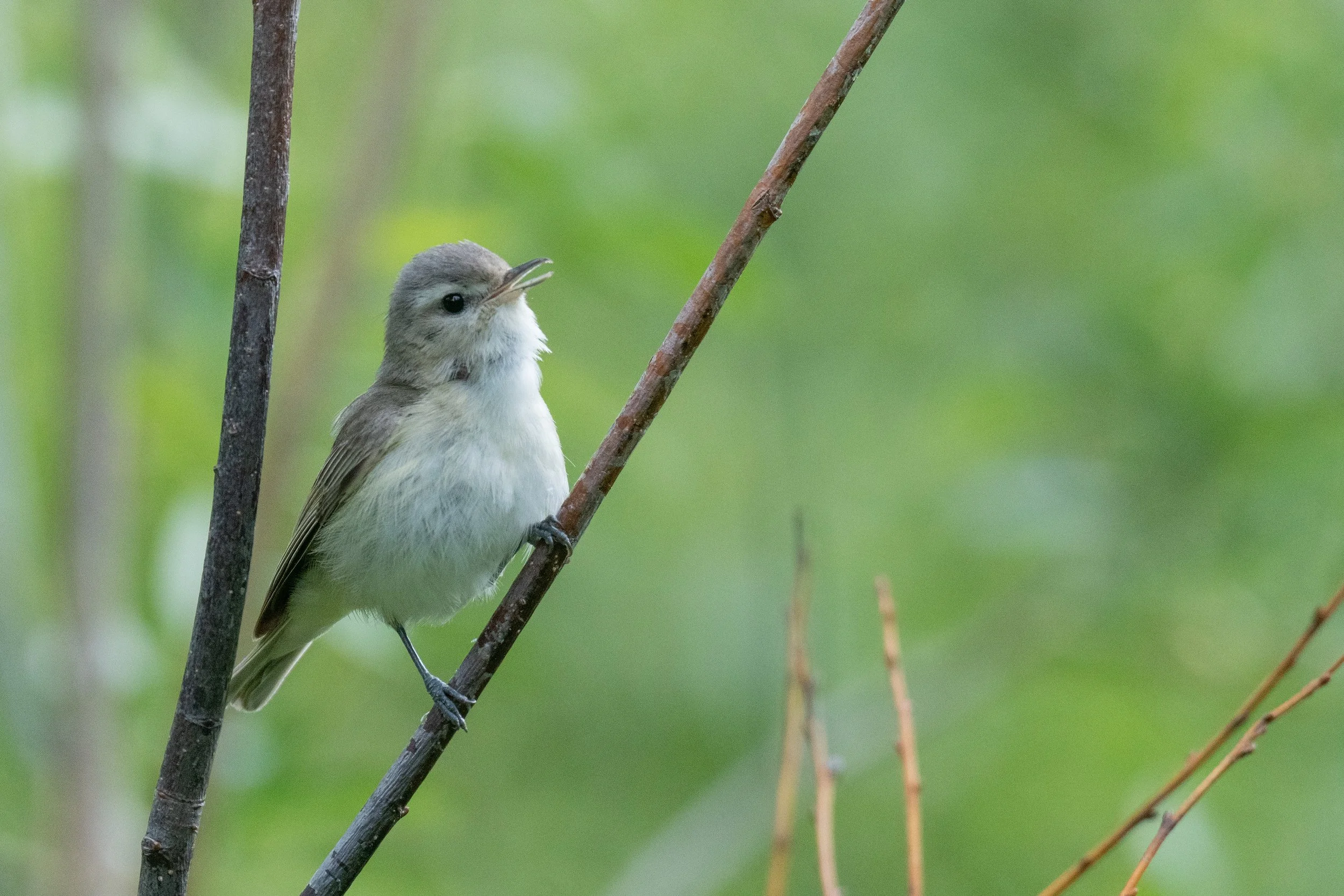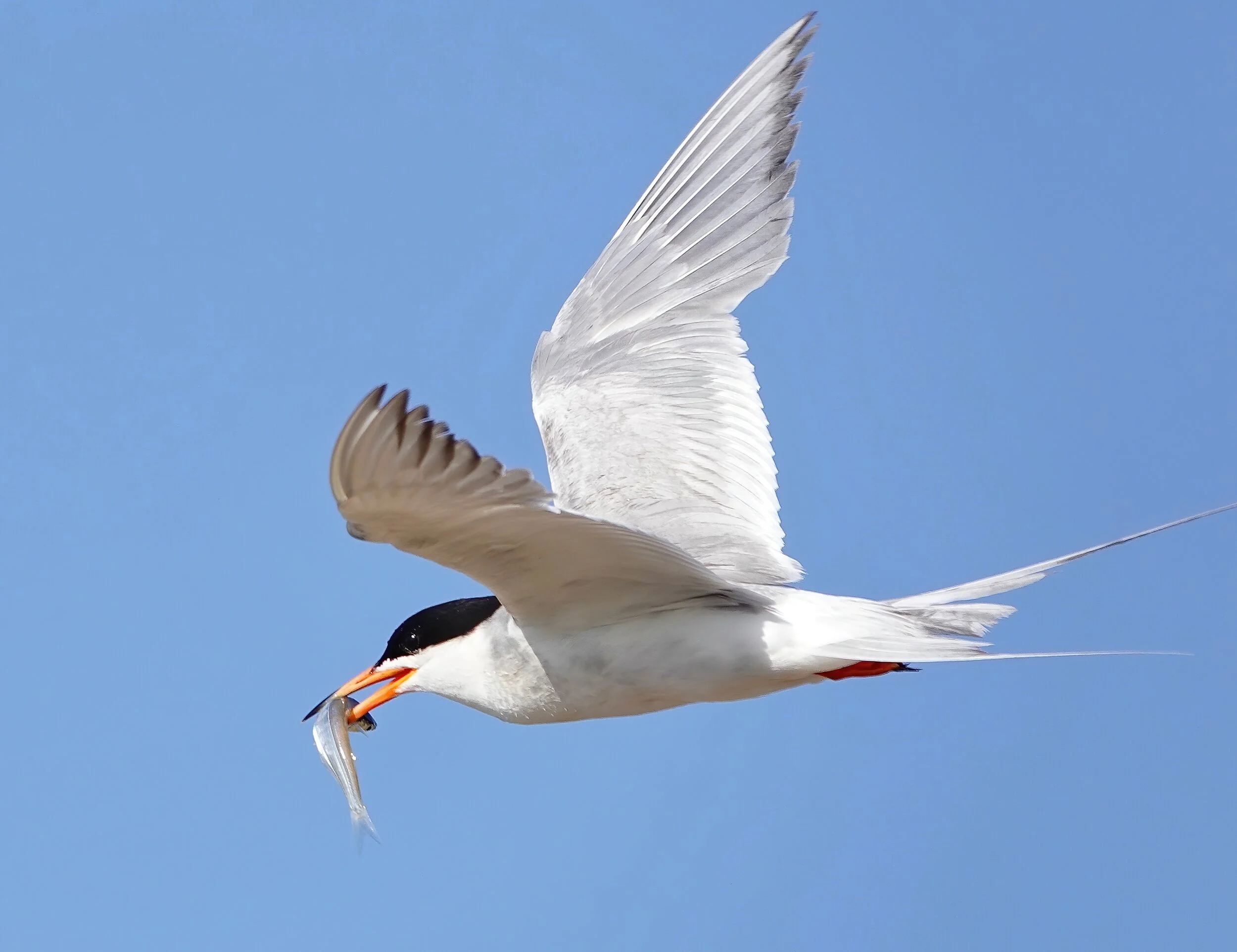San Francisco Bay is one of the most important estuaries on the west coast of North America. At its southern end, in Santa Clara County, the Bay is shallow and tidal flow is reduced. The salinity is substantially less than in the open ocean, particularly near sewage treatment plant where the inflow of fresh water further reduces salinity.
Bayfront Fall Guides
Fueled by water from the nearby water pollution control plant, Sunnyvale Baylands Park is a freshwater oasis for waterfowl and shorebirds (mostly in winter) and upland birds (year-round). Lovely, level walks throughout the park make for a pleasant stroll any time of year. This guide covers a one-mile loop around the park, hitting all the varied habitats and birds found throughout the year.
You wouldn’t think that sewage treatment would be a travel-worthy destination, but Sunnyvale Water Pollution Control Plant’s large variety of waterfowl and passerines is well worth a trip. Whether you’re looking for a 100-yard stroll from the car or a 4-mile hike, this spot provides excellent views of a large variety of bird species, all in a beautiful bay-front environment.
When thinking about ideal attributes for a fall birding location, different people might think of different features: large variety of species, good possibility for rarities, close views of birds or easily accessible without too much walking. I’m happy to say that, if you picked any of the above, New Chicago Marsh in Alviso is the place for you!
Birdwatching in the Palo Alto Baylands is excellent year-round but especially nice September through April when a large number of shorebirds are present. Plus, this is the best location in Santa Clara County to spot the endangered Ridgway’s Rail.
¡Es septiembre y las aves de la costa están llegando! Uno de los mejores lugares para verlos es la Reserva Natural de Palo Alto Baylands a mitad de la marea…
Bayfront Winter Guides
A migrant trap close to the bayfront, Charleston Road Marsh is worth visiting for a chance to find fall migrants dropping in, seek out songbirds spending the winter skulking in the shrubs, or enjoy some colorful spring travelers on their way back north. Peaceful and rarely very crowded, this marsh is an underappreciated and under-birded gem with great potential for bringing in migrants common and rare.
Fueled by water from the nearby water pollution control plant, Sunnyvale Baylands Park is a freshwater oasis for waterfowl and shorebirds (mostly in winter) and upland birds (year-round). Lovely, level walks throughout the park make for a pleasant stroll any time of year. This guide covers a one-mile loop around the park, hitting all the varied habitats and birds found throughout the year.
Along the bayfront in Mountain View, Shoreline Lake offers close-range views of waterbirds like Surf Scoters and Eared Grebes, occasional less-common species such as Horned Grebe and Barrow’s Goldeneye, and the ever-present possibility of finding an ocean-going rarity. Ducks are most numerous in winter, while in early spring, the spectacle of breeding Black Skimmers and Forster’s Terns returns to the lake.
Byxbee Park, in the Palo Alto Baylands Nature Reserve, features a hill with a 360-degree vista, grasslands studded with conceptual art, marshy sloughs, a creek and tree-lined paths, throughout which you can find wintering waterfowl, migrating passerines, soaring raptors and a variety of gulls.
This Alviso park can be good as a quick stop or a day-long adventure, with views of all different kinds of waterfowl, marsh dwellers and shorebirds. Walk along the boardwalks to listen to the noisy song birds and rails, stand at the boat dock to scan the slough for grebes and other waterfowl, or head out to the salt pond for mesmerizing murmurations of shorebirds and an impressive number of ducks.
You wouldn’t think that sewage treatment would be a travel-worthy destination, but Sunnyvale Water Pollution Control Plant’s large variety of waterfowl and passerines is well worth a trip. Whether you’re looking for a 100-yard stroll from the car or a 4-mile hike, this spot provides excellent views of a large variety of bird species, all in a beautiful bay-front environment.
Walk or bike around Pond A4 in Sunnyvale for a broad birding sample of southern San Francisco Bay in winter. Diving ducks blanket the pond, terns and pelicans fly overhead, marsh birds lurk in the surrounding channels, raptors perch on utility towers, and—as a reminder of the human footprint on the landscape—crows and blackbirds scavenge around the adjacent landfill.
Watching shorebirds and water birds up close is fun at Charleston Slough and Adobe Creek. On a short or long walk you can take the time to study their behaviors and laugh at their antics: coots swim-chase each other, egrets dash after one another with plumes flying, dabbling ducks tip over with their tail feathers in the air…
Welcome back to Emily Renzel Wetlands. It's changed a bit since we last visited it in summer, but it remains delightful, and is home to many ducks and other waterfowl. It consists of two freshwater ponds which can be birded easily in an hour and a half. Located midway between Charleston Slough and Palo Alto Baylands, it combines well (by car) with either of them.
In the winter, Coast Casey Forebay is a resting and foraging place for large flocks of water-loving birds. There is often a surprise here: an American Wigeon below the pump house, a Sora in the drainage ditch, a Wilson’s Snipe in a hidden pond. This short and easy trip is great for birders of all ages and abilities, offering you ample views of many birds gathered together in a single spot.
Wondering how many Green-winged Teal and Northern Pintail can pack themselves into a small area? Pining for a glimpse of a rare Swamp Sparrow? Read on to start planning your winter trip to the Palo Alto Baylands via the San Francisquito Creek Trail!
Birdwatching in the Palo Alto Baylands is excellent year-round but especially nice September through April when a large number of shorebirds are present. Plus, this is the best location in Santa Clara County to spot the endangered Ridgway’s Rail.
¡Es septiembre y las aves de la costa están llegando! Uno de los mejores lugares para verlos es la Reserva Natural de Palo Alto Baylands a mitad de la marea…
Bayfront Spring Guides
A migrant trap close to the bayfront, Charleston Road Marsh is worth visiting for a chance to find fall migrants dropping in, seek out songbirds spending the winter skulking in the shrubs, or enjoy some colorful spring travelers on their way back north. Peaceful and rarely very crowded, this marsh is an underappreciated and under-birded gem with great potential for bringing in migrants common and rare.
Fueled by water from the nearby water pollution control plant, Sunnyvale Baylands Park is a freshwater oasis for waterfowl and shorebirds (mostly in winter) and upland birds (year-round). Lovely, level walks throughout the park make for a pleasant stroll any time of year. This guide covers a one-mile loop around the park, hitting all the varied habitats and birds found throughout the year.
Along the bayfront in Mountain View, Shoreline Lake offers close-range views of waterbirds like Surf Scoters and Eared Grebes, occasional less-common species such as Horned Grebe and Barrow’s Goldeneye, and the ever-present possibility of finding an ocean-going rarity. Ducks are most numerous in winter, while in early spring, the spectacle of breeding Black Skimmers and Forster’s Terns returns to the lake.
If you are not sure if you are a larophobe or a larophile then come along the Adobe Creek Loop Trail between the Palo Alto Flood Control Basin and Charleston Slough in Mountain View and watch the antics of the California Gulls in their colony. We find these noisy birds so fun and hope you do too.
Just as the Ohlone people greeted the sun each morning at dawn for hundreds of years, so the swallows begin their daily swooping flights over the ponds, creeks, sloughs, and marshes of the Palo Alto Baylands. Though late spring and summer is thought of as a "quieter" time for birds, at the Palo Alto Baylands there continues to be a variety of avian species that are fascinating, interesting and entertaining to observe and enjoy.
The San Francisco Bay is a critical habitat in spring, both as a migratory stopover and as breeding grounds for many birds. Birding at the Don Edwards National Wildlife Refuge Environmental Education Center (EEC) in Alviso allows close views of the extraordinary species diversity that makes use of this habitat, all in a short distance on flat ground.
Summer is a fun time to visit Pond A16 at Don Edwards San Francisco Bay National Wildlife Refuge in Alviso. Noisy and active terns and skimmers have arrived to nest on the man-made islands in the salt pond. Come back often to see the birds in different breeding stages, from courtship to nesting to feeding their young.
Birdwatching in the Palo Alto Baylands is excellent year-round but especially nice September through April when a large number of shorebirds are present. Plus, this is the best location in Santa Clara County to spot the endangered Ridgway’s Rail.
Bayfront Summer Guides
If you are not sure if you are a larophobe or a larophile then come along the Adobe Creek Loop Trail between the Palo Alto Flood Control Basin and Charleston Slough in Mountain View and watch the antics of the California Gulls in their colony. We find these noisy birds so fun and hope you do too.
Just as the Ohlone people greeted the sun each morning at dawn for hundreds of years, so the swallows begin their daily swooping flights over the ponds, creeks, sloughs, and marshes of the Palo Alto Baylands. Though late spring and summer is thought of as a "quieter" time for birds, at the Palo Alto Baylands there continues to be a variety of avian species that are fascinating, interesting and entertaining to observe and enjoy.
Summer is a fun time to visit Pond A16 at Don Edwards San Francisco Bay National Wildlife Refuge in Alviso. Noisy and active terns and skimmers have arrived to nest on the man-made islands in the salt pond. Come back often to see the birds in different breeding stages, from courtship to nesting to feeding their young.
Summer is the time to visit Salt Pond A2E in Mountain View. You will have an opportunity to spot up to 6 species of terns plus the Snowy Plovers that are “next door” in Crittenden Marsh (Stevens Creek Nature Study Area). While the parking lot can be crowded at times on the weekends, once you are out on the trails, the crowds disperse.
Emily Renzel Ponds in Palo Alto is a small but delightful birding spot just east of US-101, about halfway between Charleston Slough and Palo Alto Baylands. It consists of two freshwater ponds and can be birded easily in an hour or so.
July through September are the months to see the small and graceful Wilson’s and Red-necked Phalaropes. These birds are usually found on the East and West Ponds of the Sunnyvale Water Pollution Control Plant. And, if you are lucky, you may even see them spin!






















A migrant trap close to the bayfront, Charleston Road Marsh is worth visiting for a chance to find fall migrants dropping in, seek out songbirds spending the winter skulking in the shrubs, or enjoy some colorful spring travelers on their way back north. Peaceful and rarely very crowded, this marsh is an underappreciated and under-birded gem with great potential for bringing in migrants common and rare.